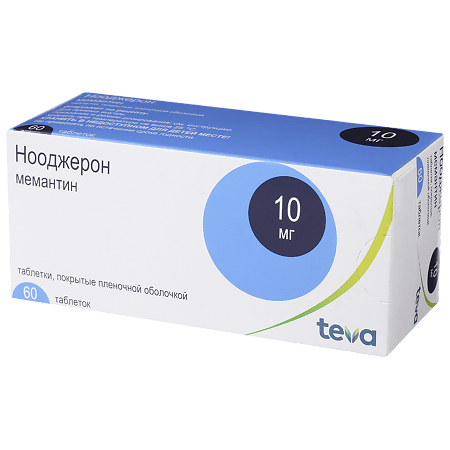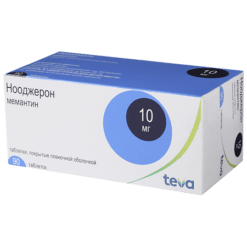No products in the cart.
Noogeron, 10 mg 60 pcs.
€1.00
Out of stock
(E-mail when Stock is available)
Description
Noogeron is a psychometabolic, nootropic.
Pharmacodynamics
A derivative of adamantane, similar to amantadine in chemical structure and pharmacological properties. It is a non-competitive antagonist of glutamate N-methyl-D-aspartate (NMDA)-receptors, (including in the black matter), due to this reduces the excessive stimulating effect of cortical glutamate neurons on neostriatum, which develops against the background of insufficient dopamine release.
By reducing the Ca2+ influx into neurons, it reduces the possibility of their destruction. It has nootropic, cerebrovasodilatory, antihypoxic and psychostimulatory effects. Has a greater effect on stiffness (rigidity and bradykinesia). It improves impaired memory and concentration, reduces fatigue and symptoms of depression.
Pharmacokinetics
It is rapidly and completely absorbed after oral administration. Cmax is reached 3-8 h after ingestion. Food has no effect on absorption. A daily dose of 20 mg results in a plasma Css of 70 to 150 ng/ml. Vd is 10 l/kg. Protein binding is 45%. 80% of circulating memantine in blood is represented by unchanged substance. Metabolism occurs without the participation of cytochrome P450. The main metabolites, N-3,5-dimethylgludantane (as 2 isomers) and 1-nitroso-3,5-dimethyl-adamantane, have no pharmacological activity.
It is excreted by the kidneys. Elimination occurs in a single phase, T1/2 is 60-100 h; clearance is 170 ml/min/1.73m2, the drug is partially secreted by the renal tubules. In alkaline urine excretion of the drug slows down.
Indications
Indications
Moderate to severe dementia in Alzheimer’s disease.
Active ingredient
Active ingredient
Composition
Composition
Active ingredient:
Memantine hydrochloride 10 mg;
Ancillary substances:
MCC – 136.8 mg;
calcium hydrophosphate – 84.5 mg;
croscarmellose sodium – 4.8 mg;
Colloidal silicon dioxide – 1.5 mg;
Magnesium stearate – 2.4 mg;
Capsule film:
Opadry II gray 45F27505 (hypromellose 2910/15 cP – 2.5 mg, polydextrose – 2.5 mg, titanium dioxide – 2.48 mg, macrogol/macrogol 4000 – 0.5 mg, iron oxide black dye – 0.02 mg) – 8 mg
How to take, the dosage
How to take, the dosage
Intentionally, regardless of meals.
In the first week, the daily dose is 5 mg (in the morning). During the second week, the daily dose is 10 mg (5 mg twice a day). During the third week, the daily dose is 15 mg (10 mg in the morning and 5 mg in the evening). From week 4, the daily dose is 20 mg. The maximum daily dose is 20 mg.
Patient special groups
Elderly patients. No dose adjustment is required in elderly patients (over 65 years of age).
Renal dysfunction. In moderate renal insufficiency (creatinine Cl 50-80 ml/min) dosage adjustment is usually not required; in creatinine Cl 30-49 ml/min daily dose initially does not exceed 10 mg, then in 7 days in case of good tolerability the dose can be increased up to 20 mg. In severe renal insufficiency (creatinine Cl 5-29 ml/min) the daily dose should not exceed 10 mg.
Hepatic impairment. In mild to moderate hepatic insufficiency (class A and B according to the Child-Pugh classification) no dose adjustment is required.
Interaction
Interaction
The effect of barbiturates and neuroleptics may be impaired when administered concomitantly.
The effects of baclofen and dantrolene may be altered by memantine, so doses may need to be adjusted.
The effects of levodopa, dopamine receptor agonists and anticholinergic agents are enhanced with concomitant use of NMDA antagonists. Due to the fact that memantine and amantadine are NMDA receptor antagonists, concomitant use should be avoided due to the risk of developing toxic effects. Combinations of memantine with ketamine, dextromethorphan and phenytoin are also potentially toxic.
The same renal cation system is used for the transport of amantadine, cimetidine, ranitidine, quinidine and nicotine in the body, which may cause interaction of these drugs with memantine, resulting in increased plasma concentrations.
When used concomitantly, memantine may cause a decrease in the serum concentration of hydrochlorothiazide.
Concomitant use with warfarin and other indirect anticoagulants requires close monitoring of PV and INR.
Special Instructions
Special Instructions
In alkaline urine, more careful monitoring of these patients is required because of delayed excretion of memantine.
Impact on the ability to drive vehicles and operate machinery.
Alzheimer’s disease is known to affect driving ability; in addition, treatment with memantine may also change reaction speed, which should be considered when driving and operating machinery.
Contraindications
Contraindications
With caution: epilepsy; renal failure; thyrotoxicosis; seizures in anamnesis; arterial hypertension; myocardial infarction in anamnesis; heart failure.
Side effects
Side effects
Nervous system disorders: dizziness, headache, somnolence, gait disturbance, confusion, hallucinations, seizures, psychosis, hyperexcitability.
Gastrointestinal disorders: constipation, vomiting, pancreatitis, nausea.
Infections and invasions: fungal infections.
Cardiovascular system: increased BP, venous thrombosis, thromboembolism.
As to the body in general: general weakness, increased fatigue, allergic reactions.
Overdose
Overdose
Symptoms: dizziness, tremor, agitation, drowsiness, confusion, agitation, stupor, seizures, aggressiveness, hallucinations, unsteady gait, vomiting, diarrhea.
Treatment: gastric lavage, administration of activated charcoal; symptomatic therapy. There is no specific antidote.
Pregnancy use
Pregnancy use
Memantine has the ability to retard fetal development. Breastfeeding should be stopped during treatment with memantine.
Similarities
Similarities
Additional information
| Shelf life | 3 years |
|---|---|
| Conditions of storage | At a temperature not exceeding 25 °C |
| Manufacturer | Teva Operations Poland Sp. z o.o., Poland |
| Medication form | pills |
| Brand | Teva Operations Poland Sp. z o.o. |
Other forms…
Related products
Buy Noogeron, 10 mg 60 pcs. with delivery to USA, UK, Europe and over 120 other countries.
















